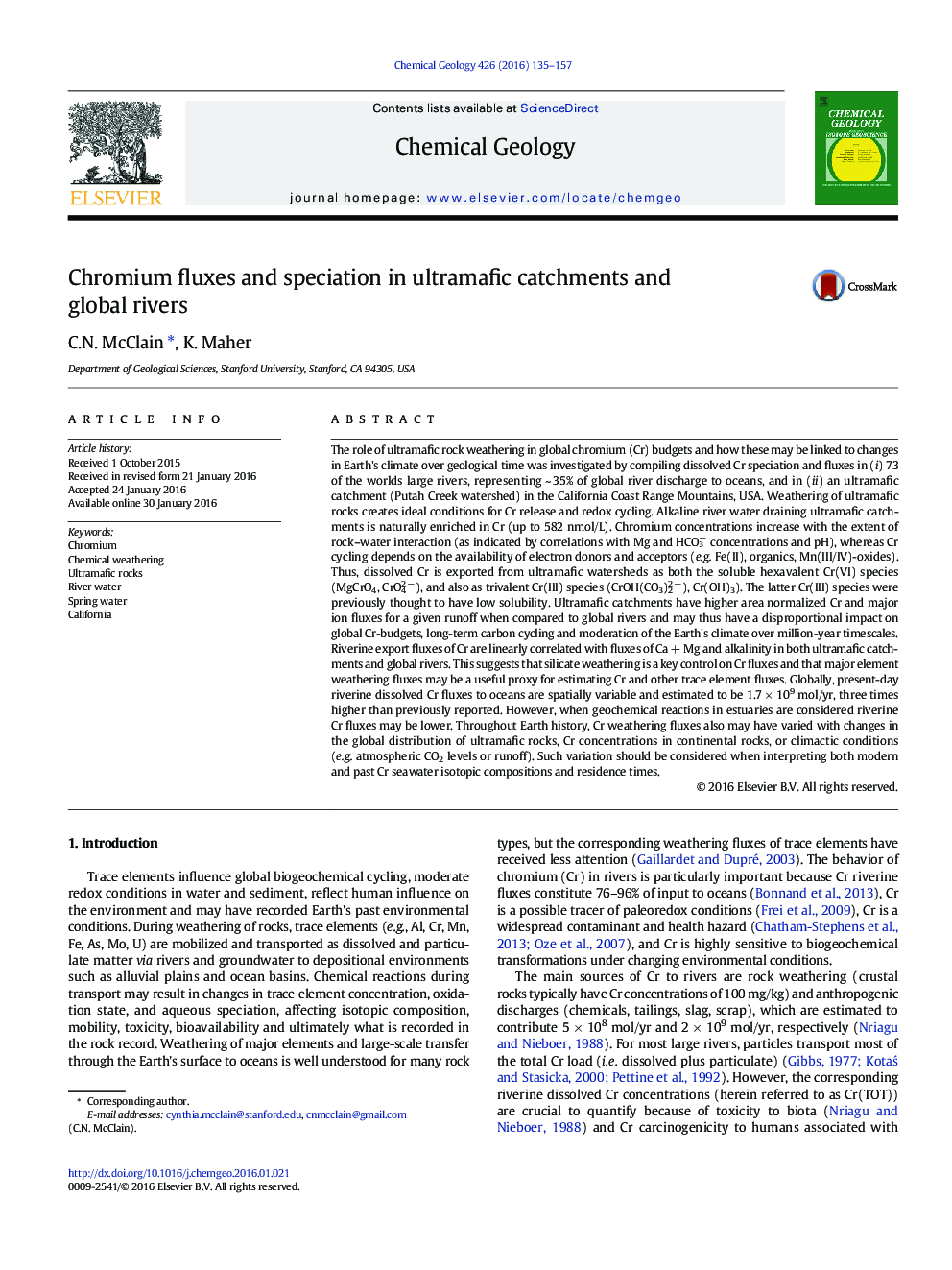| کد مقاله | کد نشریه | سال انتشار | مقاله انگلیسی | نسخه تمام متن |
|---|---|---|---|---|
| 4698336 | 1637548 | 2016 | 23 صفحه PDF | دانلود رایگان |
• Ultramafic rivers contain dissolved Cr up to 582 nmol/L as Cr(VI) (CrO42-, MgCrO4) and Cr(III) (Cr(OH)3, CrOH(CO3)22-).
• Based on 73 global rivers, modern dissolved Cr flux to oceans is 1.7 × 109 mol/yr., higher than previous estimates.
• Past riverine Cr fluxes and seawater residence times may vary with changes in continental runoff, weathering and lithology.
• Ultramafic rock weathering disproportionately contributes to global riverine Cr and bicarbonate fluxes.
• Bicarbonate and Ca + Mg weathering fluxes may be a useful proxy for Cr and other trace element fluxes globally.
The role of ultramafic rock weathering in global chromium (Cr) budgets and how these may be linked to changes in Earth's climate over geological time was investigated by compiling dissolved Cr speciation and fluxes in (i) 73 of the worlds large rivers, representing ~ 35% of global river discharge to oceans, and in (ii) an ultramafic catchment (Putah Creek watershed) in the California Coast Range Mountains, USA. Weathering of ultramafic rocks creates ideal conditions for Cr release and redox cycling. Alkaline river water draining ultramafic catchments is naturally enriched in Cr (up to 582 nmol/L). Chromium concentrations increase with the extent of rock–water interaction (as indicated by correlations with Mg and HCO3− concentrations and pH), whereas Cr cycling depends on the availability of electron donors and acceptors (e.g. Fe(II), organics, Mn(III/IV)-oxides). Thus, dissolved Cr is exported from ultramafic watersheds as both the soluble hexavalent Cr(VI) species (MgCrO4, CrO42 −), and also as trivalent Cr(III) species (CrOH(CO3)22 −), Cr(OH)3). The latter Cr(III) species were previously thought to have low solubility. Ultramafic catchments have higher area normalized Cr and major ion fluxes for a given runoff when compared to global rivers and may thus have a disproportional impact on global Cr-budgets, long-term carbon cycling and moderation of the Earth's climate over million-year timescales. Riverine export fluxes of Cr are linearly correlated with fluxes of Ca + Mg and alkalinity in both ultramafic catchments and global rivers. This suggests that silicate weathering is a key control on Cr fluxes and that major element weathering fluxes may be a useful proxy for estimating Cr and other trace element fluxes. Globally, present-day riverine dissolved Cr fluxes to oceans are spatially variable and estimated to be 1.7 × 109 mol/yr, three times higher than previously reported. However, when geochemical reactions in estuaries are considered riverine Cr fluxes may be lower. Throughout Earth history, Cr weathering fluxes also may have varied with changes in the global distribution of ultramafic rocks, Cr concentrations in continental rocks, or climactic conditions (e.g. atmospheric CO2 levels or runoff). Such variation should be considered when interpreting both modern and past Cr seawater isotopic compositions and residence times.
Figure optionsDownload as PowerPoint slide
Journal: Chemical Geology - Volume 426, 15 May 2016, Pages 135–157
